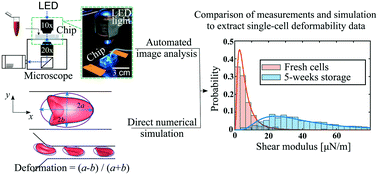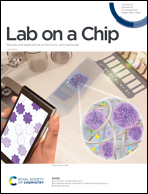A system for the high-throughput measurement of the shear modulus distribution of human red blood cells†
Abstract
Reduced deformability of red blood cells (RBCs) can affect the hemodynamics of the microcirculation and reduce oxygen transport efficiency. It is also well known that reduced RBC deformability is a signature of various physical disorders, including sepsis, and that the primary determinant of RBC deformability is the membrane shear modulus. To measure the distribution of an individual's RBC shear modulus with high throughput, we a) developed a high-fidelity computational model of RBCs in confined microchannels to inform design decisions; b) created a novel experimental system combining microfluidic flow, imaging, and image analysis; and c) performed automated comparisons between measured quantities and numerical predictions to extract quantitative measures of the RBC shear modulus for each of thousands of cells. We applied our computational simulation platform to construct the appropriate deformability figure(s) of merit to quantify RBC stiffness based on an experimentally measured, steady-state cell shape in flow through a microchannel. In particular, we determined a shape parameter based on the second moment of the cell shape that is sensitive to the changes in the membrane stiffness and cell size. We then conducted microfluidic experiments and developed custom automated image processing codes to identify and track the position and shape of individual RBCs within micro-constrictions. The fabricated microchannels include a square cross-section imaging region (7 by 7 μm) and we applied order 10 kPa pressure differences to induce order 10 mm s−1 cell velocities. The combination of modeling, microfluidics, and imaging enables, for the first time, quantitative measurement of the shear moduli of thousands of RBCs in human blood samples. We demonstrate the high-throughput features by sensitive quantification of the changes in the distribution of RBC stiffness with aging. This combined measurement and computational platform is ultimately intended to diagnose blood cell disorders in patients.



 Please wait while we load your content...
Please wait while we load your content...